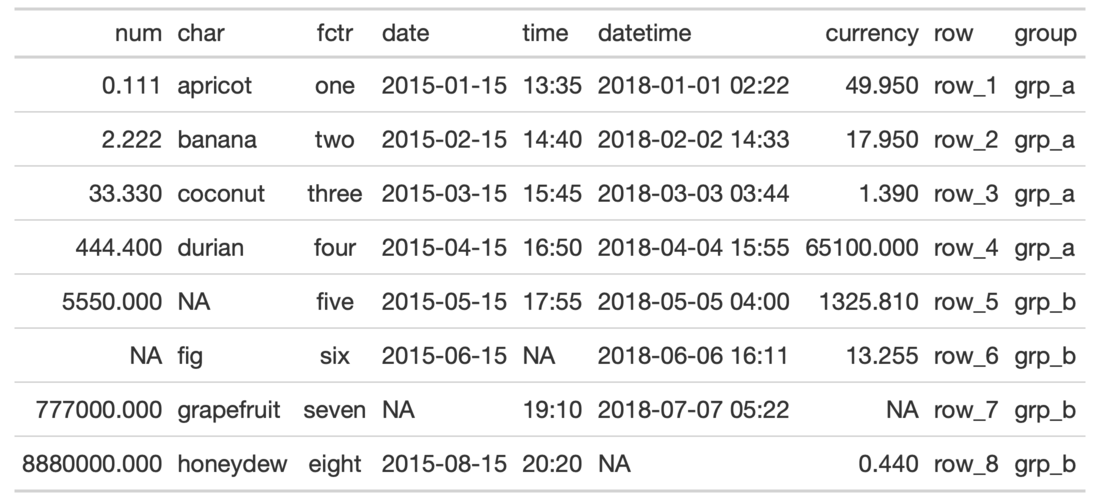With numeric values in a gt table, we can perform number-based formatting so that the targeted values are rendered with a higher consideration for tabular presentation. Furthermore, there is finer control over numeric formatting with the following options:
decimals: choice of the number of decimal places, option to drop trailing zeros, and a choice of the decimal symbol
digit grouping separators: options to enable/disable digit separators and provide a choice of separator symbol
scaling: we can choose to scale targeted values by a multiplier value
large-number suffixing: larger figures (thousands, millions, etc.) can be autoscaled and decorated with the appropriate suffixes
pattern: option to use a text pattern for decoration of the formatted values
locale-based formatting: providing a locale ID will result in number formatting specific to the chosen locale
fmt_number( data, columns, rows = NULL, decimals = 2, n_sigfig = NULL, drop_trailing_zeros = FALSE, drop_trailing_dec_mark = TRUE, use_seps = TRUE, scale_by = 1, suffixing = FALSE, pattern = "{x}", sep_mark = ",", dec_mark = ".", locale = NULL )
Arguments
| data | A table object that is created using the |
|---|---|
| columns | The columns to format. Can either be a series of column names
provided in |
| rows | Optional rows to format. Not providing any value results in all
rows in |
| decimals | An option to specify the exact number of decimal places to
use. The default number of decimal places is |
| n_sigfig | A option to format numbers to n significant figures. By
default, this is |
| drop_trailing_zeros | A logical value that allows for removal of trailing zeros (those redundant zeros after the decimal mark). |
| drop_trailing_dec_mark | A logical value that determines whether decimal
marks should always appear even if there are no decimal digits to display
after formatting (e.g, |
| use_seps | An option to use digit group separators. The type of digit
group separator is set by |
| scale_by | A value to scale the input. The default is |
| suffixing | An option to scale and apply suffixes to larger numbers
(e.g., Including Any use of |
| pattern | A formatting pattern that allows for decoration of the
formatted value. The value itself is represented by |
| sep_mark | The mark to use as a separator between groups of digits
(e.g., using |
| dec_mark | The character to use as a decimal mark (e.g., using |
| locale | An optional locale ID that can be used for formatting the value
according the locale's rules. Examples include |
Value
An object of class gt_tbl.
Details
Targeting of values is done through columns and additionally by rows (if
nothing is provided for rows then entire columns are selected). A number of
helper functions exist to make targeting more effective. Conditional
formatting is possible by providing a conditional expression to the rows
argument. See the Arguments section for more information on this.
Figures


Function ID
3-1
See also
Other Format Data:
data_color(),
fmt_currency(),
fmt_datetime(),
fmt_date(),
fmt_markdown(),
fmt_missing(),
fmt_passthrough(),
fmt_percent(),
fmt_scientific(),
fmt_time(),
fmt(),
text_transform()
Examples
library(tidyr) # Use `exibble` to create a gt table; # format the `num` column as numeric # with three decimal places and with no # use of digit separators tab_1 <- exibble %>% gt() %>% fmt_number( columns = vars(num), decimals = 3, use_seps = FALSE ) # Use `countrypops` to create a gt # table; format all numeric columns # to use large-number suffixing tab_2 <- countrypops %>% dplyr::select(country_code_3, year, population) %>% dplyr::filter( country_code_3 %in% c( "CHN", "IND", "USA", "PAK", "IDN") ) %>% dplyr::filter(year > 1975 & year %% 5 == 0) %>% tidyr::spread(year, population) %>% dplyr::arrange(desc(`2015`)) %>% gt(rowname_col = "country_code_3") %>% fmt_number( columns = 2:9, decimals = 2, suffixing = TRUE )